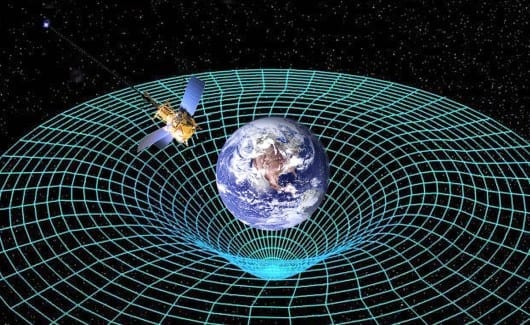
Physicists have long thought that the singularities associated with gravity (like the inside of a black hole) should vanish in a quantum theory of gravity.
It now appears that this may indeed be the case. Researchers in Uruguay and Louisiana have just published a description of a quantum black hole using loop quantum gravity in which the predictions of physics-ending singularities vanish, and are replaced by bridges to another universe.
Singularities, such as the infinitely strong crushing forces at the center of a black hole, in a physical theory are bad. What they tell you is that your description of the universe fails miserably to explain what happens as you approach the singularity. Tricks can sometimes resolve what appears to be singular behavior, but essential singularities are signs of a failure of the physical description itself.
General relativity has been summed up by the late John Wheeler’s phrase: “Spacetime tells matter how to move, matter tells spacetime how to curve.” Relativity is riddled with essential singularities, because gravity is both attractive and nonlinear – curvature in the presence of mass tends to lead to more curvature, eventually leading to trouble.
The result is rather similar to a PA system on the verge of producing a feedback whistle. If you whisper into the microphone (small gravitational fields) the positive feedback isn’t enough to send the PA into oscillation, but talking at a normal volume (larger gravitational fields) produces that horrible howl. Whispering is the comparable to the familiar actions of gravity that keep the planets and stars in their courses. The howl is the process that eventually leads to a singularity as the end result of gravitational collapse.
Let’s follow this analogy a bit further. On a PA system, the volume of the feedback is limited by the power capacity of the amplifier, so it can’t reach truly destructive levels (other than to our eardrums.) However, gravity as described by general relativity doesn’t have such a limit. Since gravity is always attractive, and eventually becomes stronger than all the (known) forces that normally give volume to matter, there is nothing to keep gravitational collapse from proceeding until the curvature of the spacetime tends toward infinity – i.e. a singularity.
Remember that this is the prediction of the classical theory of gravity, general relativity. Classical physical theories contain no fundamental limitation on mass-energy density or on the size of spacetime curvature. While this may be (and probably is) incorrect, we rarely run into a problem caused by this error, so have largely ignored the problem for centuries.
Then along came gravitational collapse and black holes. First proposed by geologist John Mitchell in 1783, a black hole is a region of spacetime from which gravity prevents anything, even light, from escaping.
The Latest Bing News on:
Quantum black hole
- One thousand academics sign an open letter to the President of Columbia University in solidarity with student protest for Gazaon April 27, 2024 at 9:39 am
The open letter was started by a group of Indian academics, many of them active in prestigious universities around the world, including Suvrat Raju, a ...
- Search for tiny black holes puts tighter constraints on quantum gravityon April 26, 2024 at 5:06 am
Developing a viable theory of quantum gravity is one of the greatest challenges in physics. Today, gravity is described very well by Albert Einstein’s general theory of relativity, which is ...
- Tweak to Schrödinger's cat equation could unite Einstein's relativity and quantum mechanics, study hintson April 26, 2024 at 2:00 am
Physicists have proposed modifications to the infamous Schrödinger's cat paradox that could help explain why quantum particles can exist in more than one state simultaneously, while large objects ...
- Opinion: America’s ‘big glass’ dominance hangs on the fate of two powerful new telescopeson April 25, 2024 at 5:13 am
Washington acknowledged the need for an 'all-sky' view of deep space but may stint on the funding. Does this make sense?
- Quantum mechanical wormholes fill gaps in black hole entropyon April 25, 2024 at 4:58 am
A new theoretical model could solve a 50-year-old puzzle on the entropy of black holes. Developed by physicists in the US, Belgium and Argentina, the model uses the concept of quantum-mechanical ...
- Explosive black hole flare from the center of our galaxy reconstructed from 'a single flickering pixel' using AI and Einstein's equationson April 23, 2024 at 10:41 am
An explosive flare from the Milky Way's central black hole has been translated from 'a single flickering pixel' into a detailed 3D model using AI and Einstein's general relativity equations.
- Manipulating the geometry of the 'electron universe' in magnetson April 23, 2024 at 5:49 am
Researchers at Tohoku University and the Japan Atomic Energy Agency have developed fundamental experiments and theories to manipulate the geometry of the "electron universe," which describes the ...
- Thermodynamic Constraints on Black Hole Entropy Modificationson April 23, 2024 at 3:46 am
Researchers propose that the Barrow entropy correction should be minimal to maintain thermodynamic stability in black holes, with potential exceptions at the Planckian regime. They demonstrate through ...
- How to destroy a black holeon April 16, 2024 at 7:17 am
A black hole would be tough to destroy, but in the season two premiere of Dead Planets Society our hosts are willing to go to extremes, from faster-than-light bombs to time travel ...
- Black Hole Mysteries: Unanswered Questions About These Cosmic Phenomenaon April 14, 2024 at 8:33 am
Black holes, those enigmatic regions in space where gravity becomes so strong that not even light can escape, have fascinated scientists, astronomers, and the public alike for decades. While ...
The Latest Google Headlines on:
Quantum black hole
[google_news title=”” keyword=”Quantum black hole” num_posts=”10″ blurb_length=”0″ show_thumb=”left”]
The Latest Bing News on:
Black hole
- Researchers advance detection of gravitational waves to study collisions of neutron stars and black holeson April 26, 2024 at 9:10 am
Researchers at the University of Minnesota Twin Cities College of Science and Engineering co-led a new study by an international team that will improve the detection of gravitational waves—ripples in space and time.
- Astronomers Discovered a Once-in-a-Lifetime ‘Sleeping Giant’ Black Holeon April 25, 2024 at 5:30 am
Stellar mass black holes, which are significantly smaller than their supermassive cousins, usually weigh in at around 10 solar masses. But the European Space Agency just found that’s more than 3 times that size.
The Latest Google Headlines on:
Black hole
[google_news title=”” keyword=”black hole” num_posts=”10″ blurb_length=”0″ show_thumb=”left”]




